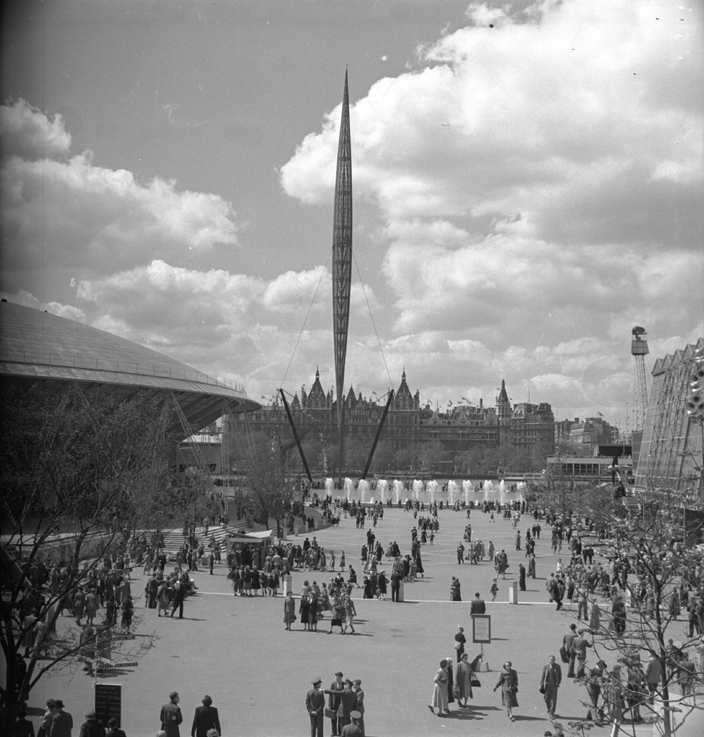Tensegrity structural systems
Tensegrity is a structural design principle that applies to a structure which can be stabilised entirely by internal pre-stress. This pre-stress is created by a discontinuous set of compression elements being opposed and balanced by a continuous tensile force.
In essence, a net of continuous tension cables or tendons (the tensioned elements), hold in place, and are themesleves held in place by, a series of discontinous bars or struts (the compressed elements).
The pioneering architect Buckminster Fuller coined the term tensegrity in the 1960s, as a combination of ‘tensional integrity’. However, the American sculptor Kenneth Snelson has long-claimed that Fuller took credit for his original idea of ‘floating compression’. Snelson defines tensegrity as follows:
| ‘Tensegrity describes a closed structural system composed of a set of three or more elongate compression struts within a network of tension tendons, the combined parts (are) mutually supportive in such a way that the struts do not touch one another, but press outwardly against nodal points in the tension network to form a firm, triangulated, prestressed, tension and compression unit.’ |
This combination of balanced elements produces an exceptionally rigid structure made up of members that do not experience bending moments. Members are loaded only in pure compression or pure tension, and will fail only if cables yield or rods buckle.
A famous example of a tensegrity structure was the Skylon, exhibited at the Festival of Britain in 1951 [see top image]. The tower was held in position by six cables, three of which were at the bottom and determined its location, while the other three were at the top and maintained its verticality.
One of the first uses of tensegrity in architecture was Spodek, an entertainment venue in Poland, designed by architects Maciej Gintowt and Maciej Krasiski in the 1960s. The roof was an inclined surface, the circumference of which was held up by a system of cables.
[edit] Related articles on Designing Buildings
Featured articles and news
CIOB report; a blueprint for SDGs and the built environment
Pairing the Sustainable Development Goals with projects.
Latest Build UK Building Safety Regime explainer published
Key elements in one short, now updated document.
UKGBC launch the UK Climate Resilience Roadmap
First guidance of its kind on direct climate impacts for the built environment and how it can adapt.
CLC Health, Safety and Wellbeing Strategy 2025
Launched by the Minister for Industry to look at fatalities on site, improving mental health and other issues.
One of the most impressive Victorian architects. Book review.
Common Assessment Standard now with building safety
New CAS update now includes mandatory building safety questions.
RTPI leader to become new CIOB Chief Executive Officer
Dr Victoria Hills MRTPI, FICE to take over after Caroline Gumble’s departure.
Social and affordable housing, a long term plan for delivery
The “Delivering a Decade of Renewal for Social and Affordable Housing” strategy sets out future path.
A change to adoptive architecture
Effects of global weather warming on architectural detailing, material choice and human interaction.
The proposed publicly owned and backed subsidiary of Homes England, to facilitate new homes.
How big is the problem and what can we do to mitigate the effects?
Overheating guidance and tools for building designers
A number of cool guides to help with the heat.
The UK's Modern Industrial Strategy: A 10 year plan
Previous consultation criticism, current key elements and general support with some persisting reservations.
Building Safety Regulator reforms
New roles, new staff and a new fast track service pave the way for a single construction regulator.
Architectural Technologist CPDs and Communications
CIAT CPD… and how you can do it!
Cooling centres and cool spaces
Managing extreme heat in cities by directing the public to places for heat stress relief and water sources.
Winter gardens: A brief history and warm variations
Extending the season with glass in different forms and terms.
Restoring Great Yarmouth's Winter Gardens
Transforming one of the least sustainable constructions imaginable.
























